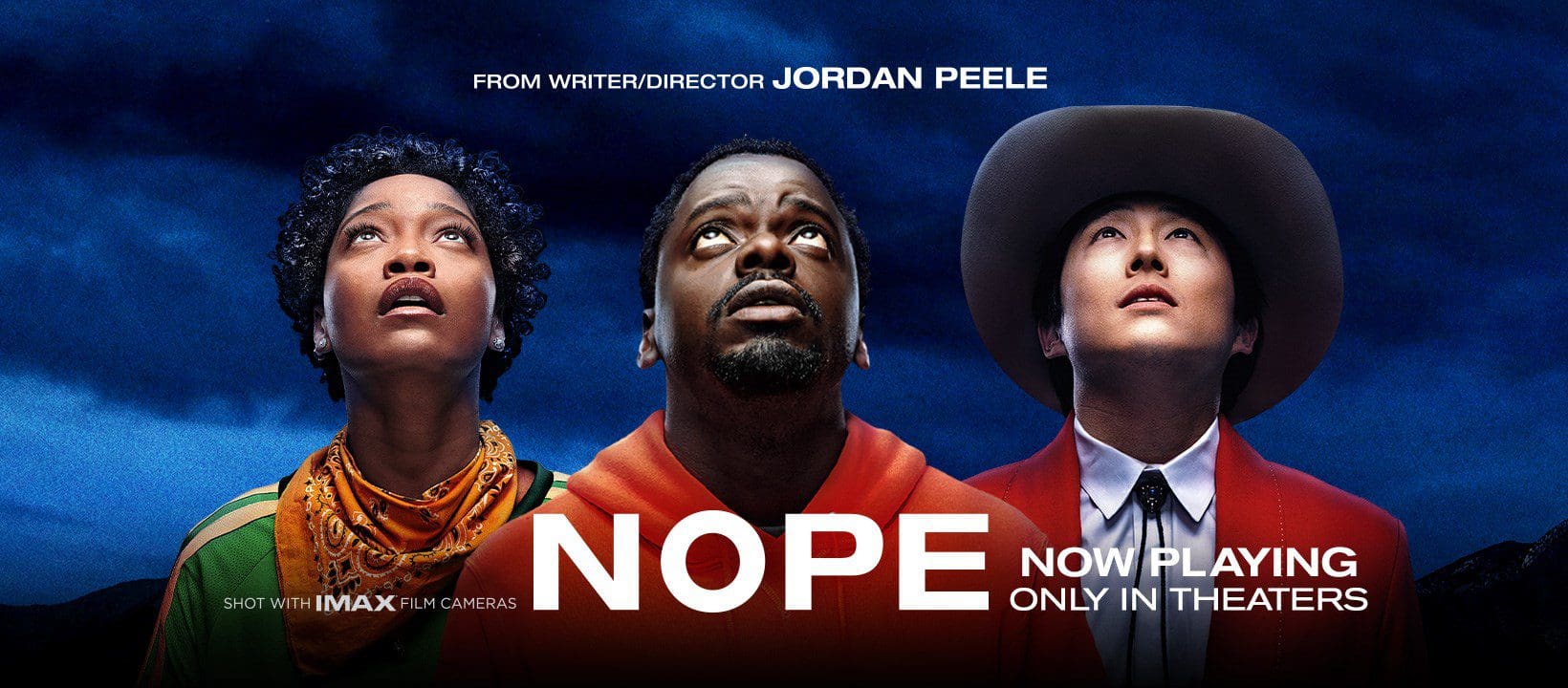
In an interview with Empire, Jordan Peele said he wrote Nope because he, “wanted to make a spectacle, something that would promote my favorite art form and my favorite way of watching that art form: the theatrical experience…..as I started writing the script, I started to dig into the nature of spectacle, our addiction to spectacle, and the insidious nature of attention. So that’s what it’s about. And it’s about a brother and sister healing their relationship.”
If you’ve seen Peele’s movies, you won’t be surprised to know there’s social commentary. If you’ve seen the film’s trailer, you won’t be surprised to know it also explores the history of film. The leads, brother and sister OJ and Emerald Haywood (Daniel Kaluuya and Keke Palmer, respectively), are the fictional descendants of the historically anonymous black horse jockey that rode a horse in the first images assembled to make a film in two seconds of footage. And, of course, there’s also a UFO.
If you know any of these details, you will go into this film searching for answers, wondering how all these elements come together into a cohesive narrative. But however disoriented you are at the start of Nope, the horror registers from one of its first shots. It’s a 70mm IMAX image of what you will come to know as the Gordy’s Home incident. Key details of this incident will be unspoiled here, but there are things the audience will correctly presume: we’re on the set of a family sitcom where something horrible happened. Through this, there is a clear juxtaposition of the intended wholesome and the unintended horror. The controlled and the uncontrollable.
The plot progresses. The audience forgets about the incident, but the search for answers continues in a universally sympathetic way. OJ and Emerald’s father, Otis Sr. (Keith David), has died. OJ (for Otis Jr.) and Sr. were training a horse when they hear a weird noise, and, suddenly, Sr. falls over. He’s not dead when OJ drives him to the hospital, but he is by the time we get there. An X-ray of his skull shows an object lodged behind his eye. Our knowledge of extraterrestrial elements, coupled with the universal unfairness of death, drives our search for answers in the otherworldly. Perhaps it’s an alien device that’s in his skull. We learn moments later of its tragic mundaneness: it’s just a nickel that fell from the sky.
We learn much later that where the nickel fell from is horrifically mundane. But until then, the Haywoods have to put food on the table, and things aren’t going well for the brother and sister. OJ had to sell some of their horses to a neighboring rodeo, but remains hopeful that they can buy them back. But as they discuss payment in Ricky “Jupe” Park’s (Steven Yeun) office, suddenly, Emerald notices an issue of Mad Magazine.
What’s merely curious for Emerald will scar the audience. Because the cover references the Gordy’s Home incident. Unaware of the history, Emerald asks Jupe about the cover’s meaning. Clearly aware of the history, Jupe nervously dances around the issue, telling her the sitcom’s basic concept, the ratings, even the SNL skit that made fun of the incident, all while showing a secret room of memorabilia he has for the show, and not a word about the horror that happened. Jupe is clearly dancing around the truth, and the audience is meant to wonder why. Is he avoiding it for sympathetic reasons or shady reasons, like a scummy realtor who doesn’t want to tell a potential buyer that someone was murdered in the house they’re looking at? As the film progresses, you realize it’s both. He’s exploiting the event just as much as he’s suppressing it, unaware of the danger involved.
The relationship between morality and exploitation in film is a difficult one. Is spectacle inherently exploitative, or can there be morality within it? G.K. Chesterton said that “fairy tales do not tell us that dragons exist, children already know that dragons exist. Fairy tales tell children the dragon can be killed.” But in the case of Nope, our heroes need to tell humanity the proverbial dragon exists. There’s a UFO on their ranch. People need to know. So they team up with cinematographer, Antlers Holst (Michael Winncott), and a local electronics store clerk, Angel (Brandon Perea), to capture footage of the UFO. The group discusses how to bait the saucer, what formats to catch it on, ranging from digital security cameras to analog IMAX film, and how they get out alive. But during this discussion, Angel asks something that gets to the core of this dilemma. He asks if they’re doing something good.
Can they put aside the money, the fame, the “Oprah Shot” as they call it, and will they be doing something good? Will they save lives, expand our knowledge of the universe, or will they simply be like the (ill-fated) TMZ jackass who trespasses on the Haywood’s property for his own personal gain?
Nope is not nihilistic. It’s not asking if art, spectacle and images have meaning, but they force us to confront our own humanity through them. What do we do with that wonder? Do we exploit it, or do we revere it? The folly of denying horror is why we hate the Mayor from Jaws, but the beauty of searching for answers is why we watch E.T. and Nope understands the value of both. The image on the film’s first poster, an abnormal cloud with a string of flags stemming from it, is featured prominently in the film. On the poster, it looks cute. But so did the dilophosaurus in Jurassic Park before it devoured Nedry, and it won’t be long before you look at those flags the way you looked at the yellow barrels in Jaws.


Comments are closed.